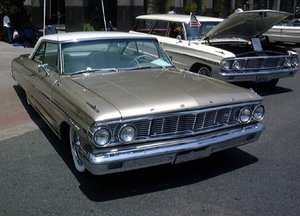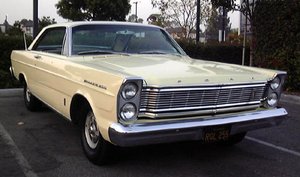Ford Galaxie
|
|
1966_Ford_Galaxie_7_Liter.jpg
- See also the Ford Galaxy minivan of the 2000s
The Ford Galaxie was a model of automobile built in the USA by the Ford Motor Company for model years 1959 through 1974. A version of the car was produced in Brazil under the names Galaxie 500, LTD and Landau from 1968 to 1982. As often is the case with American cars, the model names shifted around from year to year, but the Galaxie was always on that year's Ford full-size platform.
Some Galaxies were high-performance, racing specification machines, a larger forebear to the muscle car era. Others were plain, family sedans.
The Galaxie should not be mistaken for the Ford Galaxy, a modern-era minivan or people-mover.
| Contents |
’50s glamour
1959 saw the introduction of the Galaxie name in Ford's model lineup. That year, the Galaxie range of six models were simply upscale versions of Ford's long-running Ford Fairlane. In keeping with the era, the '59 Galaxie was a chrome- and stainless-bedecked, two-tone glitzy beauty of a vehicle, the very image of late-50s American automobile excess.
Among the models was the Skyliner Retractable, featuring a retractable hardtop that folded down into the trunk space; this feature, impressive but complicated, expensive and leaving very little trunk room when folded down, did not last long, being produced for only for '57, '58, & '59. Recently, power retractable hardtops have been used by luxury manufacturers such as Mercedes-Benz, Lexus, and Cadillac, but in all these cases the vehicle was a two-seater, allowing a much smaller top mechanism than the Skyliner's.
’60s sleek
1960's model was all-new in style, abandoning the ostentatious ornamentation of the 1950s for a futuristic, sleek look. There were tailfins still, but smaller ones -- the focus of Ford's stylists abandoning, as did the rest of the industry, the aviation influences of the previous decade and instead capturing the new obsession -- the Space Race. The Galaxie name was particularly appealing to this trend, it seems.
Hot body style this year was the Starliner, featuring a huge, curving rear observation window on a pillarless, hardtop bodyshell.
The '60 Galaxie was still accompanied by a Fairlane model, but this was its last year.
The 1961 Ford Galaxie was, for the first time, the only full-size car in the Ford lineup. The bodywork was redone again, although the underpinnings were the same as the 1960. This time, the tailfins were almost gone; replacing them, two giant circular taillights at each rear corner, glowing like a starship's engines. Ford was definitely going with the space and science-fiction theme, and with successful results; this style of Galaxie is widely regarded as a classic.
Performance was beginning to be a selling point, and the 61 Galaxie offered a new 390 cubic inch (6.4 litre) version of Ford's FE series pushrod V8, available with either a four-barrel carburetor or, for serious performance, three twin-barrel units. The latter was rated at 400 brake horsepower (300 kW), making even such a heavy car quite fast indeed.
1962 saw the same body style continue unchanged but for the front grille. A luxury version, the Galaxie 500XL was introduced; performance wasn't ignored either, with an even larger 406 cubic inch (6.7 litre) engine being available, again in triple-carburetted 'six-barrel' form. At the other end of the spectrum, of course, a 'Mileage Maker' 6 cylinder engine was available for the more budget-minded driver.
Ford saw no reason to unduly change a good thing, and the 1963 model was essentially identical in broad detail. There were now three trim levels; plain Galaxie, plusher Galaxie 500 and luxurious Galaxie 500XL.
While not much changed for the everyday buyer, for the performance oriented things were a little different - for partway through this year and in very limited quantities there became available Ford's new racing secret weapon, the 427. This new 7 litre powerplant, designed for performance rather than refinement, was offered to the public simply because racing rules required the use of only engines sold in sufficient numbers in production vehicles. Rated conservatively at 425 horsepower (320 kW), this engine also featured in Carroll Shelby's final incarnation of the AC Cobra.
1964 was the fourth and final year of this body style. Interior trim was much altered, but externally things stayed the same. Under the hood, one could no longer fit a 406 cubic inch (6.7 L) engine, the 427 cubic inch (7 L) engine totally replacing it in the lineup. Ford took the 427 cubic inch (7 L) equipped Galaxie to the racetrack in serious fashion in 1964, building a number of lightweight, fiberglass-bodied cars just for that purpose. These competed with success not only in North America but also in the United Kingdom. Initial doubts as to their competitiveness in Britain were short-lived; despite their great size and weight compared to the opposition, the Ford 427 cubic inch (7 L) engine gave them a competitive power-to-weight ratio and the handling was better than might have been supposed. They were raced in Europe reasonably successfully.
In that year Ford fitted their new engine challenger, the SOHC 427 Cammer, to a handful of Galaxies. Rated at over 600 horsepower (450 kW), this is possibly the most powerful engine ever fitted to a production car by an American manufacturer. NASCAR changed the rules, however, requiring (instead of hundreds) thousands of production examples in service to qualify for the next season, and Ford decided against producing the Cammer in that quantity. Fears of liability concerns and the bad publicity possibilities in giving the public a car that dangerously powerful are often cited as reasons, but it might simply have been that Ford doubted that an engine so unsuited to street use could sell in such numbers.
Mid-’60s
The 1965 Galaxie was an all-new car, featuring vertically stacked dual headlights in what was becoming the fashionable style in a car somewhat taller and bulkier than the previous year's. Aggression was replacing starship-sleek in stylists' minds across all the Detroit Big Three that year.
For the first time since 1960, the Galaxie was not the only full-size Ford. The base model in the range was now known as the Ford Custom, reviving a name from Ford's past. The Galaxie 500 and Galaxie 500XL were still available, but the new top-of-the-line designation was the Galaxie 500LTD. Engine choices were the same as 1964.
1966 saw a new model, the Galaxie 500 7 Litre, fitted with a new engine, the 428 cubic inch (7.01 L) Thunderbird V8. As the name suggests, this engine was also available on the Ford Thunderbird and was a response to a demand for a more docile, tractable 7-litre engine than the racing-built 427. 1966's LTD dropped the Galaxie name, a harbinger of changes to come.
In 1967, the 7 Litre model no longer carried the Galaxie name; it was to be the last year of its being separately identified. Little else changed except for trim; the same engine range, from 240 cubic inch (3.9 L) six to 428 (7.01 L) to racing 427 (7 L), the same styling.
Late-’60s to the end
The 1968 model was all-new, with distinctively different styling, reflecting the new trends. A muscle-car look was in, with a humped, 'coke-bottle' look over the rear wheels. The 'long hood, short deck' style was followed too, as was the new trend for concealed headlights, though the latter appeared only on the XL.
The Galaxie name was only carried now at one trim level, the Galaxie 500, squeezed in between the baseline Ford Custom and the higher-level Ford XL, now missing the Galaxie name. The Ford LTD stayed on as the top full-size model. This was the model produced in Brazil with minor modifications until 1982, including an alcohol engine version, typical of that country.
1969 saw the end for the Ford Custom as well as for the 427 and 428 engines. Replacing it was the new 429 ThunderJet taken from the Ford Thunderbird, part of a new Ford engine family. Power was higher than the 428 and lower than the racing-bred 427. The Galaxie 500 was now the base-model full-size Ford.
Not much changed in 1970; 1971 saw a revamp of the front end, with a more pointed, chrome-edged grille, and a reshift of the lineup. The Custom 500 was back at the low end, the XL was gone, the LTD was still the top of the line model, and the Galaxie 500 was almost as luxurious. The Ford full-size range was rapidly becoming more of a luxury car.
1974 was the last year for the Galaxie; the name was dropped for 1975. The Galaxie 500 was slightly more lavish than the low-end Custom 500, but below the middle-range LTD; a new LTD Brougham was the top-of-the-line version. Increased pollution controls were beginning to be felt, too, marking the end of the high-performance full-size car in the United States.
Today
The 1961-64 Ford Galaxies are nowadays considered fairly desirable classic cars, though prices are still in 2003 affordable except for the 427-engined cars which command premium prices. The earlier vehicles have a following, as do the 1965-67 vehicles, the 7 Litre in particular. Later Galaxies see little demand.
See also
References
- Dearborn Classics' (a full-size Ford parts catalog) Galaxie history (http://www.dearbornclassics.com/galaxie.html)


